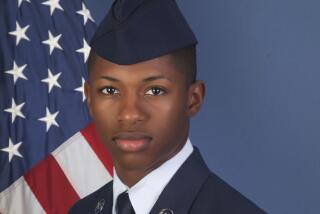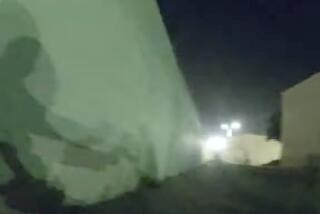Shooting Accounts at Odds in Report
Minutes after shooting an unarmed man at the end of a high-speed chase, a San Bernardino County sheriff’s deputy told a sergeant who arrived at the scene that he opened fire because the 21-year-old suspect had “charged him,” according to a confidential sheriff’s report.
But by the time he agreed to be interviewed by detectives investigating the shooting, the deputy had seen a videotape of the incident and said he used deadly force because he believed the man was going for a gun.
The statements that Deputy Ivory John Webb Jr. made to the sergeant conflict with the videotape of the Jan. 29 shooting in which Air Force policeman Elio Carrion was shot and wounded. The tape, which has been repeatedly broadcast on television and received national attention, shows Carrion kneeling and then getting shot as he follows an apparent order by Webb to stand.
Webb, 45, was charged with attempted voluntary manslaughter last week and pleaded not guilty.
The sergeant who spoke to Webb shortly after the incident said the deputy had told him that Carrion “tried to get up and lunge” at him. A Chino police officer who also arrived at the scene moments after the shooting said Webb had told him that Carrion “tried to attack” him.
When detectives tried to interview Webb hours after the shooting, he declined, saying he wanted to retain an attorney. When he finally agreed to be questioned, four days had passed and he had seen the tape of the shooting on television, according to the nearly 400-page shooting report, a copy of which was obtained by The Times.
During a tearful 2 1/2-hour interview with sheriff’s investigators, Webb said he “saw what appeared to be [Carrion’s] hand inside his jacket,” which led him to believe that Carrion was going for a gun. He said Carrion then turned toward him and said he thought, “I’m dead.”
At that instant, Webb said, he was thinking, “I’m not going to see my baby, I’m not going to see my wife. I’m not going to see my dad.”
Attorney Luis Carrillo, who represents the wounded Carrion, said he believed Webb changed his story because he knew his initial statements didn’t jibe with the tape.
“He falls back on a classic false version of events that police have used over and over again to justify bad shootings,” Carrillo said. “When they shoot an unarmed person, they claim that they saw them reach for their waistband or reach inside their jacket, causing them to fear for their lives. Thank God for the videotape. It totally destroys his false stories.”
The videotape is expected to play a crucial role in Webb’s criminal case. Though the tape is grainy and the audio is at times difficult to hear, it shows Webb shooting Carrion as he appears to be complying with the deputy’s order to “get up.”
The tape does not show Carrion lunging or charging at Webb. In fact, just before getting shot, Carrion can be heard telling the deputy that he was in the military and “on your side” and meant him “no harm.”
The shooting report said investigators had the videotape enhanced and analyzed, but the results of that analysis were not contained in the report copy obtained by The Times.
Michael D. Schwartz, an attorney representing Webb, did not return calls seeking comment.
Deputy Dist. Atty. Lewis Cope, who is prosecuting Webb, declined to comment about the deputy’s statements or any other aspect of the case.
The report contains the most detailed account to date of the incident from Webb’s perspective. It is unclear, however, whether detectives challenged Webb on the contradictions in his statements about what prompted him to use deadly force.
According to the report, Webb told detectives that on the night of the shooting, he was three hours from finishing his last shift before going on vacation. He recalled chatting on a cellphone with his wife or a friend when he heard a radio transmission from another deputy saying he was in pursuit of a dark blue Corvette. The car, the deputy added, was traveling at about 120 mph.
Webb ended his call and drove in the direction he thought the pursuit was headed so he could help.
Moments later, Webb told investigators, he heard a siren and the roar of an engine that “sounded like a rocket.”
The Corvette was headed straight for him, Webb said, forcing him to turn his patrol car to get out of the way. He then joined the pursuit, watching as the Corvette careened off a curb and went through a red light.
“What are these guys running for? Oh my God,” Webb recalled thinking at the time. “I got to catch up before they kill someone.”
The chase continued through a neighborhood in Chino, and the Corvette struck a fence and came to a stop. As the deputy approached the car, it began to rock back and forth as the occupants tried to open the doors, Webb told investigators.
When the passenger, later identified as Carrion, began to emerge, Webb drew his gun and ordered him to lie down on the ground. He told investigators that Carrion’s eyes darted back and forth “as if he were trying to find an avenue of escape.”
Meanwhile, Webb noticed movement in the car and shouted at the driver, “Let me see your hands!” He said he saw the driver reach under the seat and into the console. As Webb struggled to watch both suspects, “he believed they were working in conjunction to try and divert his attention to either flee or attack him,” according to a summary of his statement.
Webb told investigators that at that point Carrion said, “I’m going to get up” and began to rise. Webb recalled emphatically telling him not to.
Webb said that after briefly diverting his attention to the driver, he looked back at Carrion and saw that he had tucked one of his hands under his jacket.
It was then, Webb said, that he began thinking of never seeing his loved ones again. His survival instinct and police training took over, he said. He fired three shots into the area where he thought the gun would be.
Looking back, Webb told the investigators, he felt “as if he was in a whirlwind and it was spinning out of control.” He said he was “scared to death.”
Moments after the shooting, Chino Police Officer Brian Cauble arrived. With his gun drawn, Cauble said, he approached the Corvette to help Webb out.
“The deputy informed me that the passenger had just tried to attack him,” Cauble wrote.
San Bernardino Sheriff’s Sgt. Richard Swigart, who had monitored the pursuit over the radio, said he arrived just minutes after the shooting. When Swigart asked what happened, “Webb told him he had fired his weapon three times because the subject charged him,” according to a summary of Swigart’s statement to investigators.
Webb told Swigart he ordered Carrion to stay on the ground but Carrion refused to comply and “tried to get up and lunge” at him, records state.
About three hours after the shooting, as sheriff’s investigators gathered evidence and interviewed witnesses, Jose Luis Valdes, one of the neighborhood residents, approached Det. Robert Casas, according to the report.
“How is the guy doing?” Valdes asked the detective, referring to Carrion. Casas replied that he was going to be OK. Valdes then told the detective he had videotaped the incident and invited him into his home to watch it. Casas asked if other investigators could view the tape as well. “Bring them in,” Valdes said.
As Casas and five other deputies watched the tape, nobody said a word.
Then, “after the recording stopped there was total silence in the den,” according to one detective’s report.
Valdes removed the tape from the camcorder and handed it to a sergeant. “Do the right thing,” he said.
More to Read
Sign up for Essential California
The most important California stories and recommendations in your inbox every morning.
You may occasionally receive promotional content from the Los Angeles Times.











